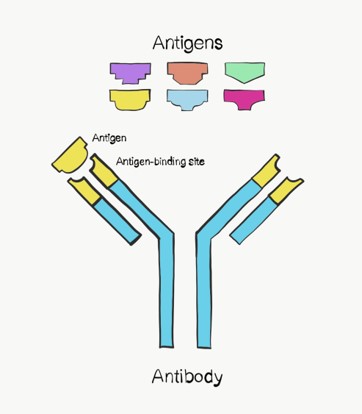The cells of the adaptive immune system attack foreign pathogens by producing proteins, such as antibodies, that use a lock-and-key mechanism to recognize pathogenic antigens, or molecules that can elicit an immune response (Figure 1). In order to defend our bodies against the millions of different pathogens that could harm us, the adaptive immune system produces countless proteins that are, in theory, capable of recognizing nearly any foreign antigen that we could encounter. Interestingly, the sheer variety of proteins expressed by adaptive immune cells is far too immense to be coded in the genome: consider the fact that there are ~20,000 protein-coding genes, yet our bodies can generate an estimated 10^30 antibodies. How, then, is this variety possible? The answer is found in the process of somatic recombination.

Somatic recombination is a type of gene rearrangement by which cells of the adaptive immune system physically cut out small regions of DNA and then paste the remaining pieces of DNA back together in an error-prone way. Because there are many ways to cut and paste the DNA, and because repairing a cut is imperfect and allows for the insertion of random DNA bases, an almost infinite number of DNA sequences can be stochastically generated. This, in turn, leads to the production of an equally infinite number of proteins. These proteins, like the antibodies produced by B-cells and T cell receptors expressed on T-cells, are unique across individual adaptive immune cells. For example, each individual B-cell (called a clone) produces a single type of antibody capable of recognizing a single set of antigens, and this antibody is different from that produced by any other B cell clone in the body (Figure 2).

However, taken together, all of the unique antibodies produced by ever B cell clone in our body can collectively recognize an innumerable quantity of antigens present on invading pathogens. Individually, though, each adaptive immune cell produces proteins that only recognize a small handful of molecules present on particular pathogens. A similar process (T cell receptor recombination) occurs for the antigen-binding genes in T-cells that encode the T cell receptor, meaning that each T cell clone also produces a unique receptor that recognizes specific antigens. Importantly, the specificity of this response is the key difference that separates cells of the adaptive immune system from those of the innate immune system.
Somatic recombination is different than somatic hypermutation (SHM), a process that takes place as part of an immune response, after a B cell has encountered antigen.
[…] receptors that T and B cells use for pathogen recognition are formed in a special process of chopping, reshuffling, and stitching together DNA. The resulting reshuffled DNA gives rise to the T- and B- cell receptors through which these […]
LikeLike